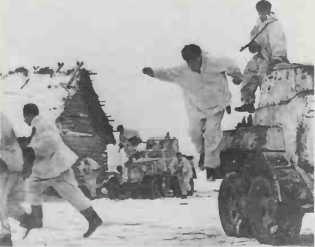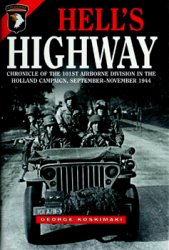Lenin, Vladimir Ilyich (Ulyanov)
(1870-1924). Russian leader of the Boshevik revolution of 1917; then Chairman of the Soviet government. Lenin’s fundamental belief was in the use of violence to achieve political aims at which he proved to be adept. On gaining power, he made peace with German}' through the Treaty of Brest-Litovsk in March 1918 and thus afforded Germany a chance of decisive attack upon France and Britain before the Americans had arrived in strength. From a long and bloody civil war in Russia, Lenin eventually emerged as the unchallenged dictator, albeit of a country now deprived of much of the territory which the Tsars had won. He was succeeded by Stalin. ANF.

Soviets advance to relieve Leningrad
Leningrad, siege of (1941-44). By the beginning of September 1941 the German Army Group North had reached the outskirts of Leningrad. Finnish troops occupied the Karelian Isthmus and German units reached the shores of Lake Ladoga on the 8th, surrounding the city. But the German advance had slowed, enabling substantial fortifications to be constructed around Leningrad; on September 13, Zhukov arrived to coordinate the defences. By the end of the month the Germans had given up hope of carrying the city by assault and settled for a siege. The incessant German bombing and shelling, together with food shortages and the severity of the Russian winter took a dreadful toll on the inhabitants. A tenuous supply line was established across the frozen Lake Ladoga and hundreds of thousands of civilians were evacuated to safety across the ice. But the main sources of relief were the sporadic Soviet offensives that drew German resources awa}' from the siege. Finally, on January 12 1943, the Soviet forces launched Operation “Iskra”, with the Leningrad garrison striking south along the lake to link up on the 18th with elements of the Volkhov Front. German artillery fire still limited the flow of supplies and reinforcements into the city but the first breach had been made in the envelopment. However, the final victory had to wait another full year until, in January 1944, an offensive forced the German lines away from Leningrad. On the 27th, Stalin formally announced the end of the siege. Some 633,000 civilians had died from starvation and a further
200,000 from enemy action. MS.
Lens. Important French coalmining town, north of Arras, occupied by the Germans in 1914. The Allies failed to retake it during the Artois operations in September 1915 and, although the Canadian Corps secured nearby Hill 70 in August 1917, Lens was not recaptured until October 3 1918.
Lent, Col Helmut (1918-44). Ger. Having claimed eight day-victories in 1939-40, Lent later became Germany’s second highest-scoring night-fighter pilot, flying Messerschmitt Bf 110s and registering a further 102 kills in over 300 night actions. An exceptional leader and marksman, he died
, landing at Paderborn.
Lentaigne, Brig ’Walter see chin-
DIT OPERATIONS.
Leopard I. West German Main Battle Tank, introduced 1965. See
Also TANKS.
Leopold III, King of the Belgians
(1901-83). Reigned 1934-50. The German invasion of the Low Countries on May 10 1940 rapidly placed Leopold, who assumed command of his army in the field, in a hopeless position which the British and French were unable to relieve. The King surrendered and remained to face the music. In France and Britain and by some in Belgium, he was unjustly held to have betrayed the cause. Controversy made his situation impossible and he eventually abdicated in 1950. ANF.
Lettow-Vorbeck, Gen Paul von
(1870-1964). Ger. Commander of German Forces in East Africa in World War I. An expert on colonial affairs on the German General Staff, having fought in China, 1900 — 01, and in Southwest Africa, 1904. His guerrilla campaign in East Africa successfully diverted British Imperial resources from more important theatres.
Lewin, Adm of the Fleet Lord
(b. l920). Br. Chief of the Defence Staff in 1982. As the Prime Minister’s principal adviser on the conduct of the Falklands campaign, he proved extremely skilful in briefing the War Cabinet, especially when confronted by sensitive issues such as the decision to torpedo the General Belgrano.
Lexington (1) US aircraft carrier. Converted from a battlecruiser design and completed in 1927, she was sunk after being severely damaged by Japanese carrier-borne aircraft at the Battle of the Coral Sea, May 8 1942. (2) The later Essex-class carrier of the same name, commissioned in 1943, supported the Tarawa, Iwo Jima and Okinawa landings as well as seeing action in the Battle of the Philippine Sea and at Leyte Gulf.
Leyte campaign (1944-45). The successful Hollandia campaign and the weakening of Japanese air power by US carrier operations allowed MacArthur to advance the initial step in the reconquest of the Philippines, the invasion of Leyte Island, from October to December 1944. On October 20, following a two-day bombardment by Rear Adm Oldendorfs support group, a 700-ship armada of Vice Adm Kinkaid’s Seventh Fleet landed Lt Gen Krueger’s Sixth Army on the east coast of Leyte. Some 132,000 men and 200,000 tons of materiel were ashore by nightfall.




 World History
World History









